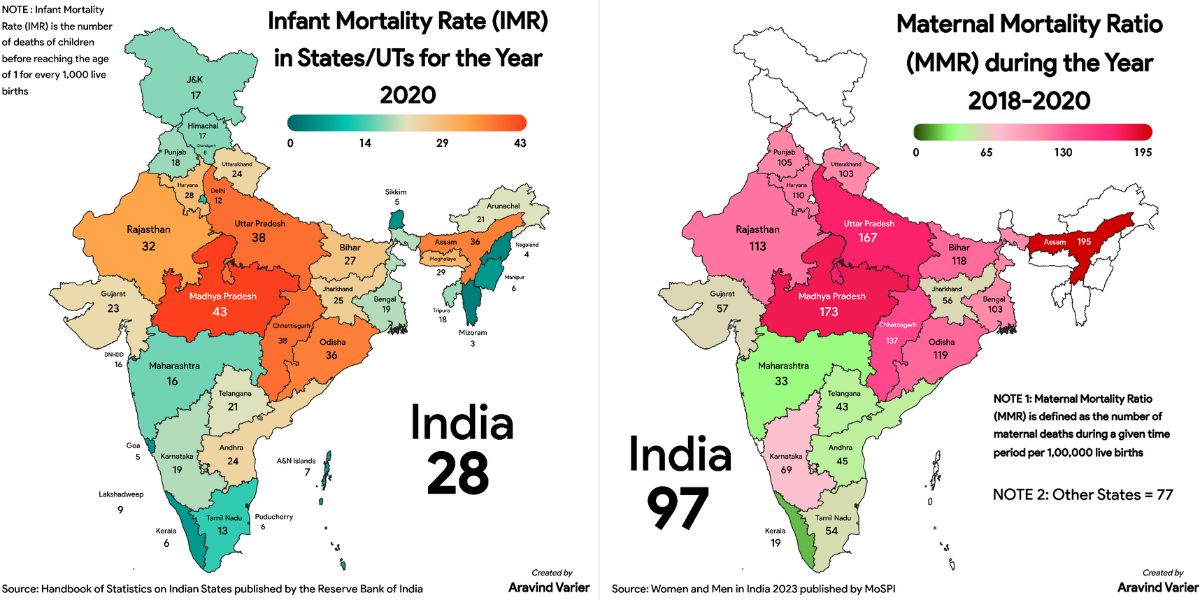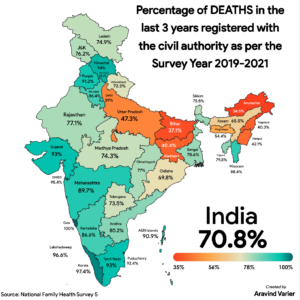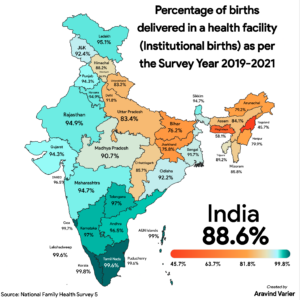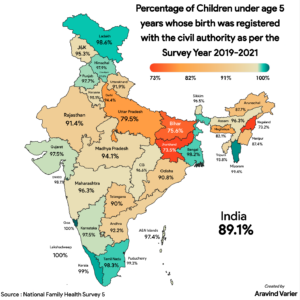Underreporting of MMR, IMR and TFR may hamper efforts to formulate effective development policies.
Published Sep 25, 2024 | 12:00 PM ⚊ Updated Nov 20, 2024 | 10:51 AM

Infant Mortality rate and Maternal mortality ration in Indian states.
Recently, I was examining the Maternal Mortality Ratio (MMR) in Indian states and checked the data used by government agencies.
An important dataset recommended by the World Health Organisation (WHO) to be used to calculate the MMR is the civil registration with complete coverage and medical certification of cause of death.
Interestingly, Government agencies in India use sample surveys rather than civil registration of births and deaths for calculating the MMR.
I decided to examine the accuracy of MMR, Infant Mortality Rate (IMR) and Total Fertility Rate (TFR) if government agencies in India decided to follow the civil registration of births and deaths as recommended by the WHO instead of sample surveys in future.

Figure 2: Percentage of deaths in the last 3 years registered with the civil authority as per the survey year 2019–2021
From the data available (Figure 2), we can clearly see that the percentage of deaths registered in some North Indian states like Jharkhand, Bihar and Uttar Pradesh is less than 50 percent. This raises the question of the accuracy of the MMR in Jharkhand, Bihar and Uttar Pradesh when more than 50 percent of deaths are not registered with the civil authority in the last three years.
Interestingly, more than 90 percent of the deaths in the past three years in South Indian states like Tamil Nadu and Kerala are registered with the civil authority and it gives us confidence that the MMR of these states are reliable when they are calculated as per the standards prescribed by the WHO.
I then examined the IMR and found a similar problem.
The available data (Figure 3) reveals that the IMR of the South Indian states is better compared to many North Indian states.
A higher IMR in many North Indian states compared to South Indian states can be attributed to the percentage of births delivered in a health facility.

Figure 4: Percentage of births delivered in a health facility (Institutional births) as per the survey year 2019–2021
When we examine the percentage of births delivered in a health facility, it is evident that more than 15 percent of the births in Uttar Pradesh are not delivered in a health facility. Same is the case with more than 20 percent of births in Bihar and Jharkhand.
The problem doesn’t end with the MMR and IMR because it gets reflected in the TFR as well.
An important dataset used by government agencies to calculate the TFR is the birth registration with the civil authority.
However, a closer look at the percentage of children below five, whose birth was registered with the civil authority is discouraging because more than 20 percent of the births of children in this age group in Uttar Pradesh, Bihar and Jharkhand are not registered with the civil authority.

Figure 6: Percentage of Children under age 5 years whose birth was registered with the civil authority as per the survey year 2019–2021
The conclusion we can draw is that India would be able to calculate accurate values of MMR, IMR and TFR as per the standards recommended by the WHO, only when child registration and death registration are improved in many North Indian states.
However, as long as we continue to follow the sample surveys without shifting to civil registration we will continue to underreport the values and it is detrimental for the policymakers in formulating developmental policies.
(Aravind Varier is a teacher and a life member of “The Indian Society for Technical Education”. He investigates the Indian state finances and is passionate about analysing the development of states through infographics. Views are personal. Edited by Majnu Babu. Editor’s note: The article has been altered after publication at the author’s request.)
